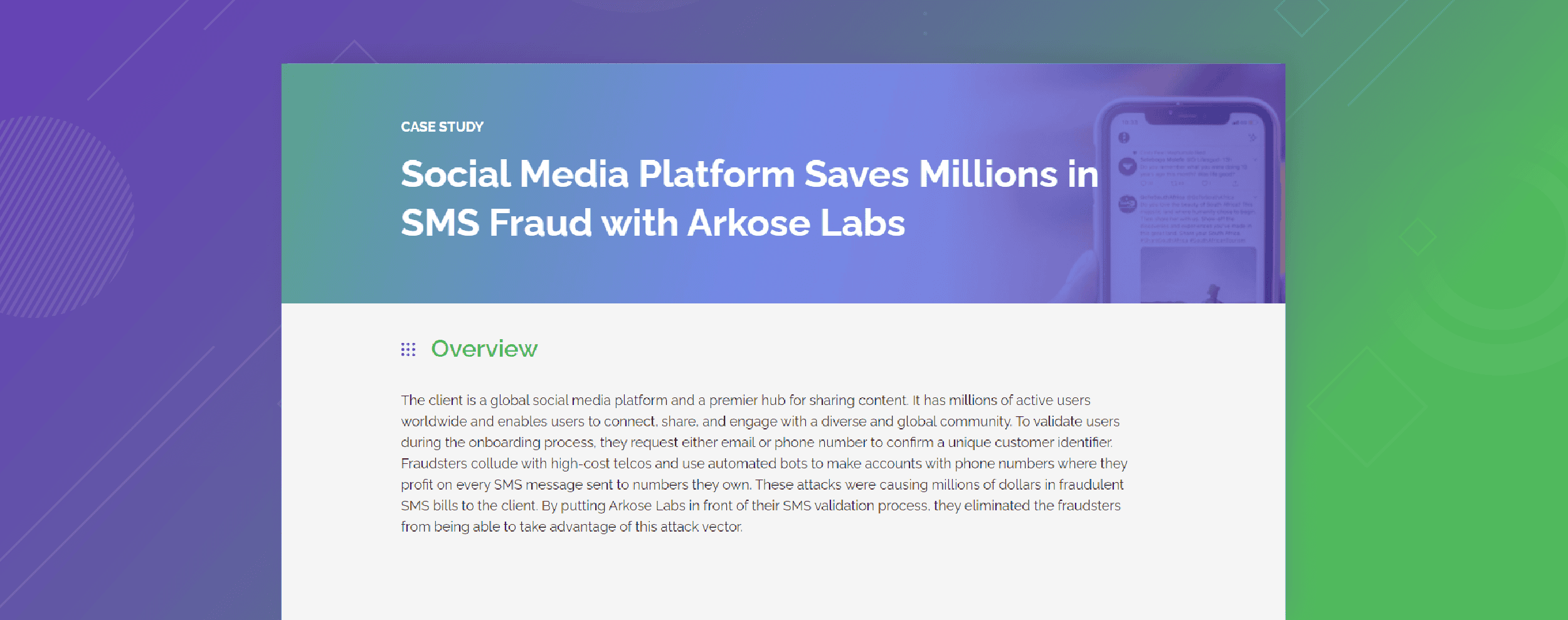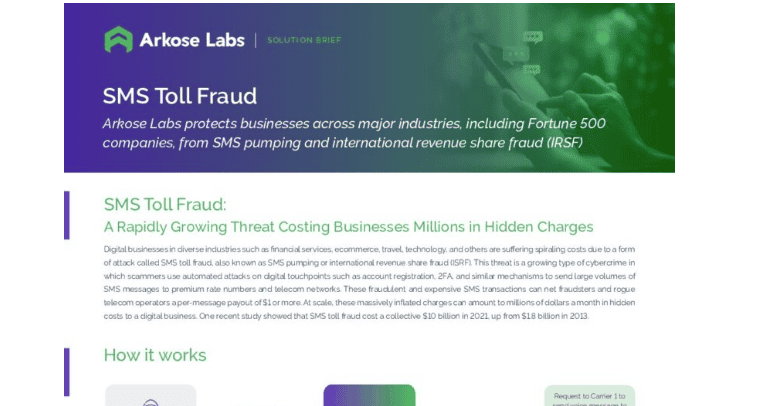Artificially Inflated Traffic Fraud: Where SMS Toll Scams Converge
The nexus of artificially inflated traffic fraud, SMS traffic pumping, and toll fraud underscores the complex interplay between cybercriminals and the telecommunications landscape. As technological advancements continue to reshape the way we communicate and conduct business, so do the tactics of bad actors.
What is artificially inflated traffic (AIT) fraud? Also known as Artificially Generated Traffic (AGT), AIT is a cunning ploy where bad actors exploit vulnerabilities within online forms and interfaces. By manipulating phone number fields, fraudsters gain access to one-time verification codes (OTPs) sent via Short Message Service (SMS). The heart of AIT fraud lies in the exponential increase in incoming web traffic, generating illicit revenue for these actors. What makes AIT particularly insidious is the intricate path between the sender and recipient of the OTP, making it challenging to trace the culprits.
The nexus of AIT and SMS fraud
Artificially inflated traffic fraud has several names, most of which refer to the various techniques used in such attacks. The nexus of AIT fraud, SMS traffic pumping, and toll fraud underscores the complex interplay between cybercriminals and the telecommunications landscape. As technological advancements continue to reshape the way we communicate and conduct business, so do the tactics of fraudsters.
SMS Traffic Pumping: The Conduit to Ill-Gotten Gains
At the core of the AIT fraud nexus lies SMS traffic pumping, a technique that capitalizes on the lucrative nature of SMS messaging. With every SMS sent, a small fee is generated, creating an avenue for profits. Fraudsters exploit the system by orchestrating massive SMS transmissions through illegitimate means. In this context, the artificially inflated traffic resulting from AIT fraud becomes a critical tool. By generating a high volume of SMS messages, fraudsters can pump revenue from multiple parties involved in the SMS transmission chain. The result? A coordinated effort to siphon off gains by exploiting the mechanics of SMS messaging.
When cybercriminals manage to execute this process on a large scale, they artificially boost the volume of incoming traffic, resulting in the generation of profits. The illicitly generated revenue, stemming from this inflated influx of activity, remains susceptible to interception by the fraudsters at various points along the path between the business dispatching the OTP and the recipient number ostensibly "requesting" it. This intricate chain of delivery makes it considerably challenging to pinpoint the instigators or complicit entities implicated in the scheme.
Toll Fraud: A Vicious Cycle Amplified
Enter toll fraud – a menace that further amplifies the profitability of SMS traffic pumping. Also known as SMS toll fraud, this threat involves the unauthorized use of communication services, often leading to financial losses for service providers. In the context of SMS traffic pumping, toll fraud is a natural offshoot. As fraudsters continue to inflate SMS traffic, they also manipulate toll-free numbers, exploiting the established revenue-sharing agreements between service providers. The impact reverberates across the telecommunications ecosystem, as legitimate businesses are saddled with exorbitant charges while fraudsters profit.
In this intricate model of deception, the collateral damage is far-reaching. Legitimate businesses face substantial financial burdens as they foot the bill for the artificially inflated traffic. Beyond financial losses, the industry's credibility is tarnished, eroding customer trust and potentially driving them toward alternative avenues. Service providers, on the other hand, grapple with the challenge of identifying and thwarting these multifaceted fraud schemes.
How AIT fraud makes money
Each transmission of an SMS message translates into financial gain for someone within the network. Typically, the mobile network operator serves as the final destination for the message's transmission, but numerous intermediaries within the chain also derive revenue from the SMS transmission process. While individual messages may only yield modest earnings, the collective impact of an escalated message count facilitates swift growth in revenue.
Examples of AIT in action
Recent reports have highlighted Elon Musk's involvement in the complex landscape of AIT, as he expressed dissatisfaction with the substantial SMS charges imposed on Twitter for its requests related to OTPs. Musk contended that Twitter suffered losses of over $60 million in the previous year due to the proliferation of bot accounts necessitating OTP SMS verification and larger SMS pumping fraud. Each of these bot-generated accounts contributes to the financial streams of several entities within the message's delivery network.
The potential for multimillion-dollar profits emerges when a significant number of such bot accounts come into existence. Musk suggested that approximately 350 Mobile Network Operators (MNOs) globally had overburdened Twitter with excessive fees as a result of AIT practices. He abstained from directly accusing MNOs of initiating the fraudulent OTP requests but asserted that they reaped gains from the situation.
Recent instances have underscored analogous incidents of AIT fraud, such as the case of a European supermarket chain. In this scenario, the unwitting business incurred substantial SMS charges within a brief timeframe, all due to the generation of OTP messages within their system. Fraudsters exploited an online form intended for enrollment in a loyalty program to orchestrate the issuance of OTP messages.
The impact of AIT fraud on businesses
The repercussions of these activities are manifold, as this insidious threat has silently crept into the business landscape, leaving a trail of financial losses, damaged reputations, and operational disruption in its wake.
- Credibility and reputation: Aside from the end-customer, as exemplified by the supermarket, who bears the brunt of an imposing bill, necessitating either payment or a dispute resolution process involving the MNO or Aggregator. More significantly, the entire industry faces tarnished credibility due to the prevalence of fraud within its systems, thereby prompting customers to seek alternative modes of conducting business.
- Revenue: These attacks encompass a wide array of tactics— including deepfakes, synthetic identity theft, AI-powered phishing attacks, and data manipulation through machine learning algorithms—all of which can bring about considerable financial fallout. Falling victim to AI-driven scams can result in substantial monetary losses, from direct theft of funds to fraudulent transactions and unauthorized access to financial accounts. Such financial hits can cripple even well-established companies, diverting resources away from growth initiatives and forcing them into a precarious financial position.
- Trust: In an era where trust is a cornerstone of business relationships, AIT fraud casts a long shadow over an organization's reputation. With the proliferation of deepfake technology, fraudsters can manipulate audio and video content to impersonate key figures within a company. This can lead to devastating consequences, eroding the trust of customers, partners, and investors, and potentially causing irreparable harm to the brand's image.
- Operational disruption: What happens when the cogs grind to a halt? AIT fraud's impact extends beyond financial losses and reputation damage; it can disrupt the very core of a business's operations. AI-powered phishing attacks, for instance, can compromise employee accounts, leading to data breaches, supply chain disruptions, and regulatory non-compliance. Businesses must allocate significant resources to repair the damage, recover data, and secure their systems, all while contending with a potential halt in their day-to-day activities.Fighting back against AIT and SMS fraud
To navigate this treacherous landscape, businesses must adopt a multi-faceted approach to counter AIT fraud. Implementing robust cybersecurity measures, educating employees about the risks, and staying vigilant for emerging threats are all crucial steps. Leveraging AI and machine learning defensively can also help identify unusual patterns and behaviors that might indicate fraudulent activity.
The Arkose Labs approach to AIT and toll fraud
Arkose Labs has emerged as a stalwart defender against these forms of fraud, equipped with innovative solutions to safeguard businesses from the crippling effects of these malicious activities. Leveraging cutting-edge technology, adaptive algorithms, and a robust understanding of evolving threat landscapes, we offer a beacon of trust in an increasingly complex digital world.
Through the capabilities of Arkose MatchKey, our state-of-the-art series of challenges with industry-leading security, we offer customers the following:
- Industry’s strongest CAPTCHA: Unlike conventional and often ineffective CAPTCHA puzzles, Arkose Labs has pioneered a revolutionary approach known as Arkose MatchKey. By gamifying the challenge-response mechanism, Arkose Labs not only deters automated bots but also creates an engaging user experience. This approach minimizes the risk of artificially inflated traffic by ensuring that only human users can navigate through the interactive challenges.
- Adaptive authentication: We employ a dynamic and context-aware authentication process that adapts to user behaviors. By analyzing various parameters, including device attributes, location data, and interaction patterns, Arkose MatchKey can differentiate between legitimate users and fraudulent actors attempting artificially inflated traffic or SMS fraud. This adaptive approach ensures that genuine users are granted access while thwarting fraudsters in their tracks.
- Real-Time Threat Intelligence: Our vast network provides real-time threat intelligence, allowing businesses to stay one step ahead of fraudsters. By identifying emerging patterns and sharing insights across its ecosystem, we equip clients with the tools they need to preemptively combat SMS fraud and other threats. This collaborative approach fosters a collective defense against fraudulent activities.
- AI-Powered Anomaly Detection: We harness the power of AI and machine learning to detect anomalies in user behavior. This technology detects deviations from expected patterns, flagging potentially fraudulent actions such as rapid-fire SMS requests or abnormal traffic spikes. By swiftly identifying these red flags, we help businesses prevent SMS fraud before it wreaks havoc.
- Behavioral Biometrics: Understanding that the essence of user behavior can be as unique as a fingerprint, Arkose Labs leverages behavioral biometrics to differentiate between legitimate users and fraudsters. By analyzing subtle nuances in interaction, such as typing speed, mouse movements, and touch gestures, Arkose MatchKey creates a multi-dimensional profile of each user, adding an additional layer of protection against SMS fraud and other malicious activities.
- Global Threat Network: Our extensive global threat network pools together insights from a diverse range of industries and regions. This wealth of information enables the identification of emerging trends and the crafting of tailored defenses against specific threats, including artificially inflated traffic fraud and SMS fraud.
Find out how Arkose Labs can help your business stay protected from AIT and other types of SMS fraud. Book a demo today!
- Artificially Inflated Traffic Fraud: Where SMS Toll Scams Converge
- The nexus of AIT and SMS fraud
- SMS Traffic Pumping: The Conduit to Ill-Gotten Gains
- Toll Fraud: A Vicious Cycle Amplified
- How AIT fraud makes money
- Examples of AIT in action
- The impact of AIT fraud on businesses
- The Arkose Labs approach to AIT and toll fraud



